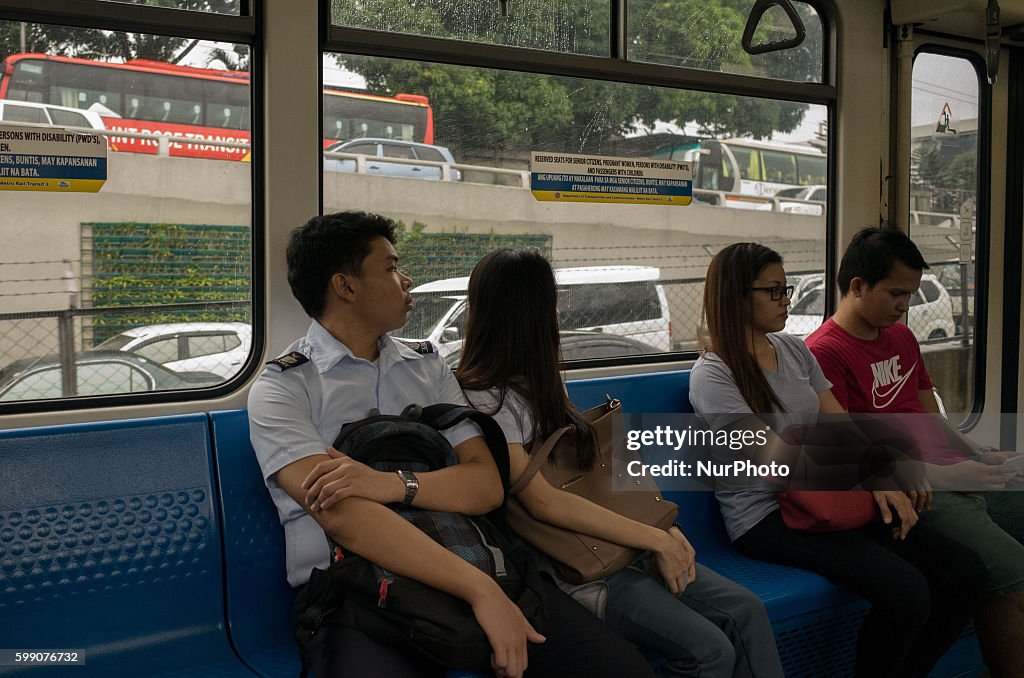Philippines Railways remain inefficient despite privatization
In this photo dated August 9, 2016, Filipinos ride the Metro Rail Transit, as northbound traffic in Ayala district crawls slowly in Metropolitan Manila, Philippines. Excluding the Philippine National Railways system, the Light Rail Transit (LRT) and the Metro Rail Transit (MRT) systems, with its corresponding Purple, Blue, and Yellow lines, make up a majority of Metro Manila's railway system, serving 2.1 million passengers on a daily basis. With the premise of improvements in service, the Philippine government, through no less than former president Benigno "Noynoy" Simeon Aquino III, led the charge in having the LRT and MRT systems privatized, claiming that the government was losing valuable money in subsidizing train fares, arguing that Filipinos from Visayas and Mindanao regions shouldn't be paying for something they will never get to utilize, and that the subsidies should be put in other departments. Despite promises of improvements in services which would be brought by increasing train fares through privatization of the aforementioned train systems, both the LRT and MRT systems remain wraught with glitches and delays, as well as marked with inefficiency with long lines even after the morning and evening rush hour becoming a common and accepted occurence, with the only visible change seen by commuters is a contactless smart card system called the "beep card," which replaced the magnetic card-based system. Activists from cause-oriented groups such as the umbrella group Bagong Alyansang Makabayan (New Patriotic Alliance), which have criticized the Philippine government's train privatization scheme as deceptive and anti-people, have challenged the train fare hikes and the privatized state of the train systems to the Supreme Court, and are currently awaiting an affirmative decision. Newly-elected President Rodrigo Roa Duterte has promised in his inaugural State of the Nation Address to increase the train capacity, as well as decreasing the train headway interval and

PURCHASE A LICENSE
How can I use this image?
$375.00
CAD
Getty ImagesPhilippines Railways remain inefficient despite privatization, News Photo Philippines Railways remain inefficient despite privatization Get premium, high resolution news photos at Getty ImagesProduct #:599076732
Philippines Railways remain inefficient despite privatization Get premium, high resolution news photos at Getty ImagesProduct #:599076732
 Philippines Railways remain inefficient despite privatization Get premium, high resolution news photos at Getty ImagesProduct #:599076732
Philippines Railways remain inefficient despite privatization Get premium, high resolution news photos at Getty ImagesProduct #:599076732$575$175
Getty Images
In stockDETAILS
Restrictions:
Contact your local office for all commercial or promotional uses.TO GO AS SERIES "Philippines: Railways remain inefficient even with privatiztion"
Credit:
Editorial #:
599076732
Collection:
NurPhoto
Date created:
August 09, 2016
Upload date:
License type:
Release info:
Not released. More information
Source:
NurPhoto
Object name:
mendoza-philippi160809_npSWN
Max file size:
4097 x 2714 px (13.66 x 9.05 in) - 300 dpi - 2 MB